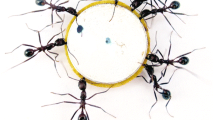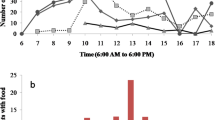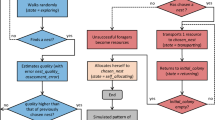Summary
Eciton burchelli workers frequently form groups to retrieve large prey items. Such groups have a definite structure. There is a constant relationship between total ant dry weight and prey item dry weight for both individual porters and groups, and this relation is such that a larger weight of ant or ants can carry disproportionately heavy items. Furthermore, all prey items are carried at a standard retrieval speed. This means that groups are superefficient; they can carry items that are so large that if they were fragmented the original members of the group would be unable to carry all the fragments. Groups also have a distinct caste distribution. There is a significant tendency for each group to have a single submajor, the specialist porter caste in Eciton burchelli. These findings which were verified by experiments suggest that groups fulfill the criteria of efficient teams. The biomechanics are proposed to explain the superefficiency of groups. The organization of co-operation is considered as is the role of teams in the economy of these societies. Colony caste profiles can only be understood by examining the role of teams which form a plastic supercaste.
Similar content being viewed by others
References
Franks NR (1985) Reproduction, foraging efficiency and worker polymorphism in army ants. In: Hölldobler B, Lindauer M (eds) Experimental Behavioural Ecology and Sociobiology. Fortschr Zool 31: 91–107
Gotwald WH (1982) Army Ants. In: Hermann HR (ed) Social Insects IV. Academic Press, New York London pp 157–254
Grasse PP (1959) La reconstruction du nid et les co-ordinations interindividuelles chez Bellicositermes natalensis et Cubitermes sp. La theorie de la stigmergie: Essai d'interpretation du comportement des termites constructeurs. Insectes Soc 6:41–83
Hölldobler B (1984) Evolution of Insect Communication. In: Lewis T (ed) Insect Communication. Academic Press, London New York, pp 349–371
Hughes GM (1965) Locomotion: Terrestrial. In: Rockstein M (ed) The Physiology of Insecta II. Academic Press New York, pp 227–253
Jensen TF, Holm-Jensen I (1980) Energetic cost of running in workers of three ant species, Formica fusca L., Formica rufa L. and Camponotus herculeanus L. (Hymenoptera, Formicidae) J Comp Physiol [B] 137:151–156
Nielsen MG, Jensen TF, Holm-Jensen I (1982) Effect of load carriage on the repiratory metabolism of running worker ants of Camponotus herculeanus (Formicidae). Oikos 39:137–142
Oster GF, Wilson EO (1978) Caste and ecology in the social insects. Princeton University Press, Princeton
Schmidt-Nielsen K (1984) Scaling: Why is animal size so important? Cambridge University Press, London New York
Sudd JH (1963) How insects work in groups. Discovery, (Sune 1963) 15–19
Wilson EO (1971) The insect societies. Belknap Press of Harvard University Press, Cambridge
Author information
Authors and Affiliations
Rights and permissions
About this article
Cite this article
Franks, N.R. Teams in social insects: group retrieval of prey by army ants (Eciton burchelli, Hymenoptera: Formicidae). Behav Ecol Sociobiol 18, 425–429 (1986). https://doi.org/10.1007/BF00300517
Received:
Accepted:
Issue Date:
DOI: https://doi.org/10.1007/BF00300517




